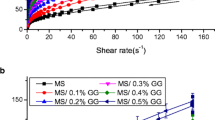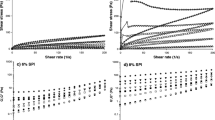Abstract
The shear-thinning low, medium and high-viscosity fiber preparations (0.15–1.05 % psyllium husk, 0.07–0.6 % guar gum, 0.15–1.20 % gum tragacanth, 0.1–0.8 % gum karaya, 0.15–1.05 % high-viscosity Carboxy Methyl Cellulose and 0.1–0.7 % xanthan gum) showed that the consistency coefficient (k) was a function of concentration, the relationship being exponential (R2, 0.87–0.96; P < 0.01). The flow behaviour index (n) (except for gum karaya and CMC) was exponentially related to concentration (R2, 0.61–0.98). The relationship between k and sensory viscosity rating (SVR) was essentially linear in nearly all cases. The SVR could be predicted from the consistency coefficient using the regression equations developed. Also, the relationship of k with fiber concentration would make it possible to identify the concentration of a particular gum required to have desired consistency in terms of SVR.


Similar content being viewed by others
References
Allen LH (2013) Dietary fiber: Role in nutritional management of disease. In: Encyclopedia of Human Nutrition 2:55–59. doi:10.1016/B978-0-12-375083-9.00107-0
Amiri EO, Nayebzadeh K, Mohammadifar MA (2015) Comparative studies of xanthan, guar and tragacanth gums on stability and rheological properties of fresh and stored ketchup. J Food Sci Technol 52(11):7123–7132
Anderson JW, Floore TL, Geil PB, O’Neal DS, Balm TK (1991) Hypocholesterolemic effects of different bulk-forming hydrophilic fibers as adjuncts to dietary therapy in mild to moderate hypercholesterolemia. Arch Intern Med 151:1597–1602
Belitz HD, Grosch W (1999) Food Chemistry. Springer-veralg, Berlin pp 285-311
Cevoli C, Balestra F, Ragni L, Fabbri A (2013) Rheological characterization of selected food hydrocolloids by traditional and simplified techniques. Food Hydrocoll 33:142–150
Chen J (2009) Food oral processing – a review. Food Hydrocoll 23:1–25
Craig SAS, Holden JF, Troup JP, Auerbach MH, Frier H (1999) Polydextrose as soluble fiber and complex carbohydrate. In: Cho SS, Prosky L, Dreher M (eds) Complex Carbohydrates in Foods. Marcel Dekker Inc., NY, p. 235
Cui SW, Nie S, Roberts KT (2011) Functional properties of dietary fiber. Canada, Elsevier, B.V., pp. 517–525
Fiszman S, Varela P (2013) The role of gums in satiety/satiation. A review. Food Hydrocoll 32:147–154
Kaur S, Shevkani K, Singh N, Sharma P, Kaur S (2015) Effect of guar gum and xanthan gum on pasting and noodle-making properties of potato, corn and mung bean starches. J Food Sci Technol 52(12):8113–8121
Launay B, Doublier JL, Cuvelier G (1986) Flow properties of aqueous solutions and dispersions of polysaccharides. In: Mitchell JR, Dedward DA (eds) Functional properties of Food Macromolecules. Elsevier Applied Sci. Publ, London, pp. 1–76p
Marcotte M, Taherian HRA, Ramaswamy SH (2001) Rheological properties of selected hydrocolloids as a function of concentration and temperature. Food Res Intl 34:695–703
Moskowitz HR (1972) Scales of subjective viscosity and fluidity of gum solutions. J Texture Stud 3:89–100
Mudgil D, Barak S, Khatkar BS (2014) Guar gum: Processing, properties and food applications- a review. J Food Sci Technol 51(3):409–418
Oakenfull D (2001) Physicochemical properties of dietary fiber: Overview. In: Cho SS, Dreher ML (eds) Handbook of dietary fiber. Marcel Dekker, Inc. Newyork, 197p
Phillips, G.O. and Williams, P.A. (2009) Handbook of Hydrocolloids. 2ndedn. Cambridge, Woodhead Publishing limited.
Roberfroid MB (1999) Dietary fiber properties with health benefits of non-digestible oligosaccharides. In: Cho SS, Prosky L, Dreher M (eds) complex Carbohydrates in Foods. Marcel Dekker, Inc, New York, pp. 25–27p
Szczesniak AS, Farkas E (1962) Objective characterization of the mouthfeel of gum solutions. J Food Sci 27:381–385
Thibault JF, Lahaye M, Guillon F (1992) Physico-chemical properties of food plant cell walls. In: Schweizer TF, Edwards CA (eds) Dietary fiber – A Component of Food. ILSI Human Nutrition Reviews. Springer-Verlag, London, pp. 21–39
Topping DL (2013) Dietary fiber: Physiological effects and health outcomes. In: Encyclopedia of Human Nutrition 2:50–54. doi:10.1016/B978-0-12-375083-9.00106-9
Waldt LM (1961) Technology of natural gums and stabilizers. Food Process 22(4):122
Werbin SJ (1953) Vegetable gums, their properties and uses. Baker’s Digest 27(4):71
Acknowledgments
Main author thanks National Dairy Research Institute, Karnal, India for the award of Institute Senior Fellowship. Authors do not have any conflict of interest.
Author information
Authors and Affiliations
Corresponding author
Additional information
Highlights
• The shear-thinning low, medium and high-viscosity fiber preparations (0.15–1.05 % psyllium husk, 0.07–0.6 % guar gum, 0.15–1.20 % gum tragacanth, 0.1–0.8 % gum karaya, 0.15–1.05 % high-viscosity CMC and 0.1–0.7 % xanthan gum) showed that the consistency coefficient (k) was a function of concentration, the relationship being exponential (R2, 0.87–0.96; P < 0.01).
• The flow behaviour index (n) for psyllium husk, guar gum, gum tragacanth, 0.1- and xanthan gum was exponentially related to concentration (R2, 0.61–0.98).
• The relationship between k and sensory viscosity rating (SVR) was essentially linear in nearly all cases.
• The SVR could be predicted from the consistency coefficient using the regression equations developed.
• The relationship of k with fiber concentration would make it possible to identify the concentration of a particular gum required to have desired consistency in terms of SVR.
Appendix
Appendix
Intensity rating of sensory viscosity of hydrocolloid solutions/dispersions in water

Rights and permissions
About this article
Cite this article
Arora, S.K., Patel, A.A., Kumar, N. et al. Determination of relationship between sensory viscosity rating and instrumental flow behaviour of soluble dietary fibers. J Food Sci Technol 53, 2067–2076 (2016). https://doi.org/10.1007/s13197-016-2193-0
Revised:
Accepted:
Published:
Issue Date:
DOI: https://doi.org/10.1007/s13197-016-2193-0




